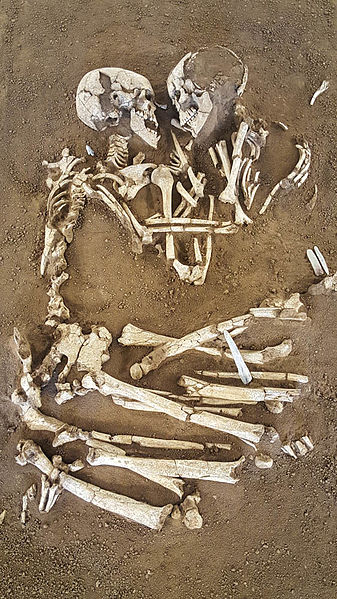It’s been about twelve years since the discovery of a Neolithic tomb near Mantua, Italy set archaeologists’ hearts aflutter. In this land associated with Shakespeare’s famous pair of tragically short-sighted and love-besotted teenagers, a team of archaeologists led by Elena Maria Menotti uncovered a six-thousand-year-old tomb for two. Inside were two skeletons, a male and female, with their arms and legs entwined.
And that’s when the team proved they’d paid attention in high school English class and demonstrated their worthiness to be involved in such a find by incessantly quoting Romeo & Juliet. Located in the village of Valdaro, the couple has become known as the Valdaro Lovers, and they represent the only such entwined remains ever to have been found.

Unlike their Shakespearian counterparts, the Neolithic lovers evidently managed to survive the throes of perpetual hormonal concussion associated with human teenagers. While it’s not impossible that they died in one another’s arms, according to researchers, the bodies were most likely arranged in a peaceful embrace after death.
Their deaths may have been somewhat less tragic, but their eternal embrace touching. While most Neolithic skeletons are studied bone by bone, the Valdaro Lovers have never been separated, and I suppose that’s the way it should be.
We are living in a world in which the most often referenced example of literary love is a couple of teenagers who were convinced to commit suicide rather than survive the flush of their first intense crush. Separation, divorce, and heartbreak seems more common than a relationship that lasts a lifetime. So, it’s nice, especially on Valentine’s Day, to think of a couple whose love has survived millennia.

Besides, who doesn’t like a good hug? Research suggests that those of us giving and receiving regular hugs—at least 8 per day—are probably reaping some significant health benefits. Hugs lower stress, strengthen our immune systems, reduce pain, and boost oxytocin levels.
Apparently, that wasn’t enough for the young lovers of Vadaro, but they’ll keep trying. Thanks in part to the efforts of an association called the Lovers of Mantua, led by Professor Silvia Bagnoli, the two will remain forever entwined and on exhibit at the National Archaeological Museum of Mantua. This decision presents a difficulty when it comes to studying the couple, meaning their story—what pieces we might be able to find of it—may remain undiscovered. But it doesn’t really take fancy science to see the makings of a good love story.
Happy Valentine’s Day!

Nothing like a good love story, especially on Valentine’s Day! 🙂
I think it must have been a good love story.
Now I really want to know the story of these tragic skeleton lovers. But wait, are they hugging? Could these two have been the stars of the Neolithic Wrestling Federation? If they ever find a broken chair nearby, we’ll know the truth.
I like that thought. Perhaps some imaginative writer should flesh out the story.
Flesh! Look at you and your ghoulish puns :))
What an interesting Valentine post! 🙂 Are hugs still so beneficial if they’re with a cat who yowls and struggles to get out of the hug? Lol.
Well, maybe not for the cat. 🙂
https://wp.me/paMnvJ-v